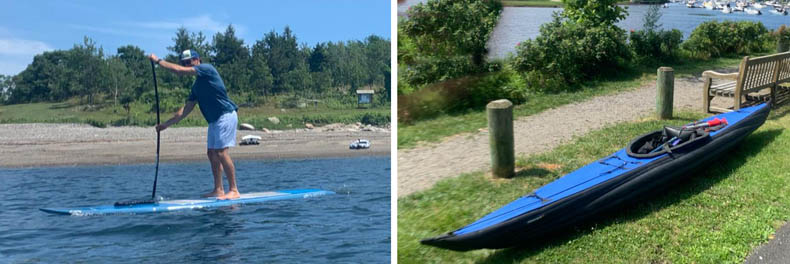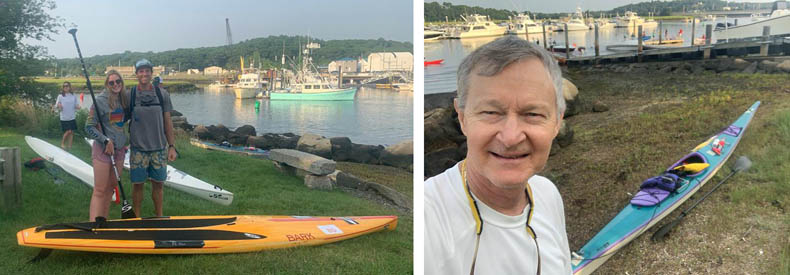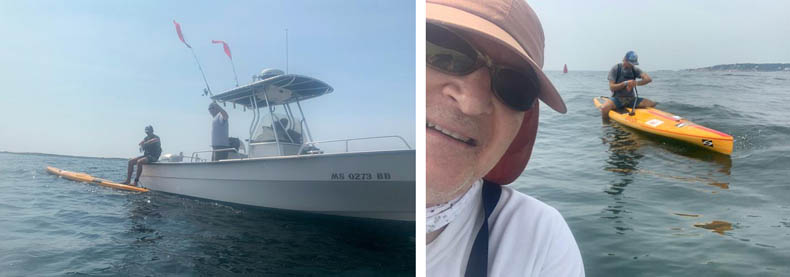|
|
|
Blackburn Challenge 2021
As Bob Blair, President of the Cape Ann Rowing Club put it, the Covid pandemic has been like a "full on curve ball." After canceling last year's annual Blackburn Challenge, the Club decided to host a "Scaled Down Event" this year on August 7th. The race committee had lost several members, and volunteers were scarce, but committee member Suzanne Sweeney said the revised event made their jobs "a little easier considering their staffing challenges." The major changes as documented on the race website were: no first time racers, a 200-person limit, no formal start or timing, no awards, and most disappointing, no post-race party. In the past, the event drew 400 or more people to Pavilion Beach for the finish and after party, but Gloucester COVID restrictions would not allow such a large event, even if held outdoors. This year's rules changes didn't stop 120 hardy souls from participating in 74 boats of all types including kayaks, surfskis, paddleboards, canoes, rowing shells, and traditional row boats. For a list of participants, see the results sheet and photos posted on the website.
L: Dana Gaines' 29th Challenge 2021. (Photo by Glen Tines) R: Ben and John at the finish in 2011.
I first paddled the Blackburn in 1997 with my friend Dan Boyne in a wooden Baidarka double kayak. I raced again with Ben Zorfas in 2011 in another double kayak. Ben was in high school at the time, and it was his first introduction to the Challenge. Like many, he became hooked and has raced almost every year since — lately atop a paddleboard.
L: Ben's recreational paddleboard. R: John's Aironaut. Over the next three weeks, I took time off from work to paddle alone and with Ben, and redeveloped some of the strength and stamina I'd remembered from years before. Also lucky for me, the generous Publisher of this magazine offered me a different boat — an 18-foot Necky Arluk 1.8. Since I was a former Necky dealer, I was familiar with the model, though I wasn't sure my long bony legs would fit in its tiny cockpit. With the foot pegs and seat back moved to their extreme positions, the boat fit like a glove and the highly rockered hull responded well to even slight body movements. It was fast and a joy to paddle — especially in rougher seas.
L: Cassie, Ben, and the Bark racing paddleboard. R: John with his borrowed Arluk 1.8.
Ben and I met one last time a few days before the Challenge. Me in my Arluk and he on his newly borrowed 14-foot Bark Dominator racing board. Both of us noticed vast improvements in speed, and our paces were well matched, but I felt a bit cramped, and Ben was a little worried about his balance in waves. We dismissed these worries and decided to take the Challenge, but only if winds were predicted at ten knots or less.
Exiting the Annisquam River. After exiting the river at the Annisquam Lighthouse, we no longer fought current. Seas were flat and wind dead calm all the way around the tip of Cape Ann to Straitsmouth Island. My leisurely paddling easily kept up with Ben. At the Straitsmouth Gap, the wind and current both picked up and they were opposed. This combined with "clapotic" waves produced choppy seas which presented a challenge to Ben. He had to focus mainly on his balance and staying upright, so his strokes were not as powerful, but the current kept us moving in the right direction. At around 10:00 a.m., two-and-a-half hours after our start, we reached the halfway check point and called out our numbers to race organizers on the safety boat. They looked us over with some obvious worry, maybe wondering if we'd be able to finish within the advised maximum allotted time of six hours.
Taking a break with Brian after three hours of paddling. When Ben turned towards me and asked, "What do you think?", I knew he was not a happy camper. Luckily, he had arranged for his friend Brian to meet us with his powerboat so we could take a break. Ben was able to stand up and relax on the gunnel of Brian's boat, while I had to remain jammed into the Arluk's tiny cockpit for fear of flipping if I tried to exit onto a higher rocking boat. My legs were beginning to cramp as I couldn't change leg positions without losing connection to the foot pedals, but the break and additional fluids seemed to help. Ben asked if I would finish the challenge if he bowed out. I answered yes but encouraged him to continue since the current was with us and it took little effort to make progress. He had only to focus on balance until the current changed or the wind died, and calm seas returned. Ben decided to continue, and Brian agreed to check on us in an hour or so.
L: Ben still standing. R: John with cramping legs. (Photos by Glen Tines) Another hour passed and sure enough calm seas returned. The only problems were my cramped legs losing touch with the foot pegs, and Ben's fatigue. I paddled on using only upper body strength with no foot bracing, and Ben dropped to his knees to save energy. We noticed the safety boat keeping a watchful eye on us, but eventually the officials seemed to feel comfortable about our finishing, and they buzzed off to check on the few other stragglers behind us. As we rounded the last turn at the breakwater and entered Gloucester Harbor, we came upon Matt McCambridge in his Emotion Bliss plastic kayak with beautiful wooden Greenland-style paddle. Matt had started about the same time as we did five hours earlier. He had admirably paddled the distance in his short boat — only ten feet six inches long (he'd sawed off part of the stern to allow it to travel inside his Prius).
L: Ben and Matt McCambridge near the finish. R: Ben, Cassie, and friends at the finish.
The three of us paddled along at a relaxed pace the last two miles to the finish at Pavilion Beach where a small crowd, mostly socially distanced, applauded our efforts. Ben and Matt definitely deserved the accolades after five hours and 40 minutes of paddling their relatively sluggish craft. Turns out we were not the slowest participants. That title went to Rick Miles who rowed the route in six hours and 13 minutes in his dory work boat. The fastest time at 2:51 was logged by Robert Jehn on his Epic V12 surfski. Not sure which of these two gentlemen deserves the most admiration.
|
|
|











